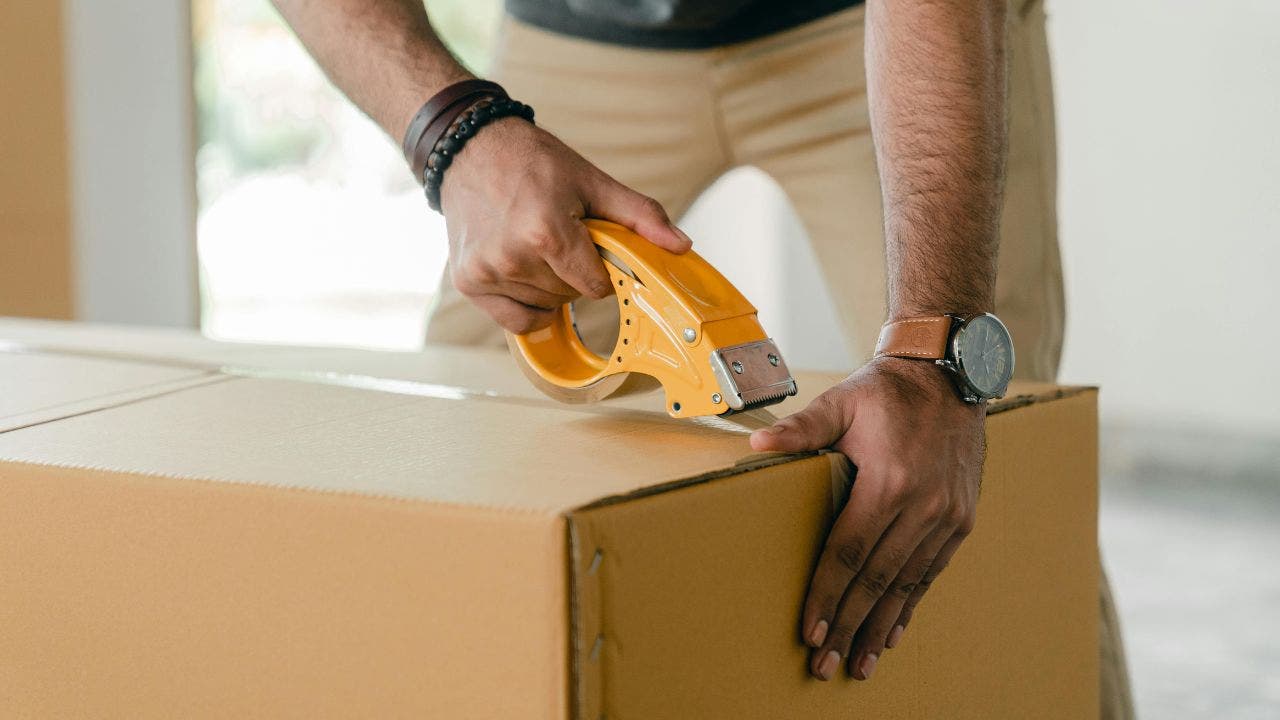Technology
How to avoid becoming a moving scam victim

Moving to a new home can be an exciting yet stressful experience. As you prepare for this significant life change, it’s crucial to be aware of potential pitfalls, particularly when it comes to choosing a moving company.
Unfortunately, moving scams are more common than you might think, and they can turn your exciting relocation into a nightmare. Understanding the risks and taking precautions can protect yourself and ensure a smooth transition to your new home.
GET SECURITY ALERTS, EXPERT TIPS – SIGN UP FOR KURT’S NEWSLETTER – THE CYBERGUY REPORT HERE
Man taping a moving box (Kurt “CyberGuy” Knutsson)
The alarming reality of moving scams
Moving scams remain a significant problem, particularly during the peak moving season from May to August. In 2023, the Better Business Bureau (BBB) received 5,918 complaints against moving companies. Consumers who fell victim to moving scams and reported them to BBB Scam Tracker in 2023 lost a median of $350.

A mover lifting a moving box (Kurt “CyberGuy” Knutsson)
BEST HOME SECURITY SYSTEMS
6 types of moving scams
Scammers have developed various tactics to take advantage of unsuspecting movers. Being aware of these common scams can help you stay vigilant and protect yourself:
1) Stolen belongings: Movers disappear with your property after loading the truck.
2) False quote: Movers demand more money on moving day, claiming unexpected circumstances.
3) Non-refundable deposit: Scammers take a deposit and never show up.
4) No-shows: Movers fail to appear after taking a large up-front payment.
5) Last-minute changes and charges: Unexpected fees for additional labor or supplies
6) Hostage load: Movers demand more money after loading your belongings, refusing to unload until paid.

A mover loading a moving truck (Kurt “CyberGuy” Knutsson)
HOW TO NEVER GET LOCKED OUT OF YOUR HOUSE EVER AGAIN
Warning signs of a moving scam
Recognizing red flags early can save you from falling victim to a moving scam. Here are some key warning signs to watch out for:
- There is no physical address on the website
- No U.S. DOT number. A U.S. DOT number is a unique identifier assigned by the Department of Transportation to commercial vehicles and moving companies. It helps track safety records and ensures the company is registered and follows regulations. If a moving company doesn’t have a U.S. DOT number, it could be a sign that they are not legitimate or properly regulated, which is a red flag for a potential scam.
- Estimates are given over the phone instead of in person or via video walk-through.
- Movers arrive in rented trucks instead of company-branded vehicles.
- Requests to sign blank or incomplete forms
KURT’S PICKS: EARLY LABOR DAY DEALS

A mover moving boxes (Kurt “CyberGuy” Knutsson)
HOW YOUR HOUSE CAN KEEP YOU HEALTHY: 5 COOL NEW INNOVATIVE PRODUCTS
How to protect yourself
Taking proactive steps to safeguard your move is essential. Here are some strategies to help you avoid becoming a victim of a moving scam:
Research thoroughly: Use resources like the Federal Motor Carrier Safety Administration’s (FMCSA) database, ATA MSC’s ProMover directory and BBB profiles
Get multiple in-home estimates: Obtain at least three estimates and be wary of significantly lower quotes
Keep a paper trail: Get everything in writing, including estimates, inventory, order of service and the bill of lading
Inventory your belongings: Make a detailed list and take time-stamped photos or videos
Use a credit card for payment: Avoid cash, gift cards or cash transfer apps
Supervise the move: Be present during loading and unloading or have a trusted representative
Use tracking devices: Consider using Apple AirTags or similar Bluetooth trackers to monitor your property during the move
Understand your rights: Review the FMCSA’s booklet on estimates, invoices and liability for loss or damage.
Verify the company: Ensure they have a physical address, U.S. DOT number and proper licensing.
Be cautious of large up-front payments: While deposits are standard, be wary of requests for large sums before moving day.
HOW TO REMOVE YOUR PRIVATE DATA FROM THE INTERNET

A mover taping a moving box (Kurt “CyberGuy” Knutsson)
If you’ve been scammed
You may still fall victim to a moving scam despite your best efforts. If this happens, it’s important to act quickly and know your options for recourse:
1) File a complaint with the FMCSA online or via their hotline (888-368-7238)
2) Report to the U.S. DOT Office of Inspector General online or via hotline (800-424-9071)
3) Submit a report to the BBB’s Scam Tracker
4) Notify your state’s attorney general or consumer protection office
5) Contact local police if items or money have been stolen

A couple carrying moving boxes (Kurt “CyberGuy” Knutsson)
Kurt’s key takeaways
Moving can be a stressful experience, and the threat of scams adds an extra layer of concern. However, staying informed and taking proactive steps can significantly reduce the risk of falling victim to moving fraud. Following the guidelines outlined in this article and maintaining a cautious approach can ensure a smoother, safer moving experience. Remember, investing time in selecting a reputable mover is one of the most important steps you can take to protect yourself and your belongings during this significant life transition.
What additional precautions or resources do you think are necessary to further protect people from moving scams? Let us know by writing us at Cyberguy.com/Contact.
For more of my tech tips and security alerts, subscribe to my free CyberGuy Report Newsletter by heading to Cyberguy.com/Newsletter.
Ask Kurt a question or let us know what stories you’d like us to cover.
Follow Kurt on his social channels:
Answers to the most asked CyberGuy questions:
New from Kurt:
Copyright 2024 CyberGuy.com. All rights reserved.

Technology
Amazon is ‘winding down’ some of its DEI programs
/cdn.vox-cdn.com/uploads/chorus_asset/file/23935560/acastro_STK103__03.jpg)
As we head toward the end of the year, I want to give another update on the work we’ve been doing around representation and inclusion.
As a large, global company that operates in different countries and industries, we serve hundreds of millions of customers from a range of backgrounds and globally diverse communities. To serve them effectively, we need millions of employees and partners that reflect our customers and communities. We strive to be representative of those customers and build a culture that’s inclusive for everyone.
In the last few years we took a new approach, reviewing hundreds of programs across the company, using science to evaluate their effectiveness, impact, and ROI – identifying the ones we believed should continue. Each one of these addresses a specific disparity, and is designed to end when that disparity is eliminated. In parallel, we worked to unify employee groups together under one umbrella, and build programs that are open to all. Rather than have individual groups build programs, we are focusing on programs with proven outcomes – and we also aim to foster a more truly inclusive culture. You can read more about this on our Together at Amazon page on A to Z.
This approach – where we move away from programs that were separate from our existing processes, and instead integrating our work into existing processes so they become durable— is the evolution to “built in” and “born inclusive,” instead of “bolted on.” As part of this evolution, we’ve been winding down outdated programs and materials, and we’re aiming to complete that by the end of 2024. We also know there will always be individuals or teams who continue to do well-intentioned things that don’t align with our company-wide approach, and we might not always see those right away. But we’ll keep at it.
We’ll continue to share ongoing updates, and appreciate your hard work in driving this progress. We believe this is important work, so we’ll keep investing in programs that help us reflect those audiences, help employees grow, thrive, and connect, and we remain dedicated to delivering inclusive experiences for customers, employees, and communities around the world.
Technology
Chinese auto giant wants to make flying cars your next commute option

GAC Group, a prominent automotive manufacturer from China, is making waves in the transportation sector with the launch of its new eVTOL brand, Govy.
This development reflects GAC’s commitment to sustainable air travel, as the company taps into its extensive automotive expertise and innovative technology to create fresh solutions for urban mobility.
With Govy, GAC is not just entering the flying car market; it’s setting the stage for a new era in how we think about commuting and connectivity in our cities.
I’M GIVING AWAY THE LATEST & GREATEST AIRPODS PRO 2
Flagship aircraft of Govy named AirJet. (Govy)
Introducing the AirJet
The flagship aircraft of Govy, named AirJet, is a revolutionary composite-wing flying car designed to operate as an air taxi for distances of up to 124 miles. This innovative vehicle combines the efficiency of fixed-wing aircraft with the flexibility of multi-rotor systems, allowing for vertical takeoff and landing capabilities.
The AirJet is constructed with over 90% carbon fiber composite materials, making it remarkably lightweight — just one-third the weight of a conventional car of similar size. This lightweight design not only enhances performance but also enables longer electric flights.
WHAT IS ARTIFICIAL INTELLIGENCE (AI)?

Flagship aircraft of Govy named AirJet. (Govy)
EVTOL PROTOTYPE PROMISES 150 MPH CITY-TO-CITY HOPS
Performance and features of the AirJet
In terms of performance, the AirJet is powered by GAC’s proprietary electric drive system, which allows it to reach impressive speeds of up to 155 miles per hour. The current model boasts a range exceeding 124 miles, with ambitious plans to extend this range to 249 miles through the development of future solid-state battery technology. Additionally, the AirJet can be recharged in just 30 minutes, ensuring quick turnaround times for operations.
The AirJet is designed with both luxury and safety in mind. It features a spacious cabin with a “1+1+X” seating arrangement that provides flexibility for passengers. The aircraft is equipped with autonomous flight capabilities, allowing for seamless operation without human intervention. Safety is paramount in the design of the AirJet. It includes advanced safety systems such as redundant power and control systems, real-time monitoring, and obstacle detection to ensure secure flights.

Flagship aircraft of Govy named AirJet. (Govy)
AN ELECTRIC AIRCRAFT THE MILITARY HAS ITS EYES ON CAN TAKE OFF WITH ONLY 150 FEET OF RUNWAY
The robo-air taxi system
GAC’s vision extends beyond individual aircraft to encompass a comprehensive Robo-AirTaxi system that integrates ground and aerial transport for end-to-end smart mobility solutions. This system will utilize the Govy AirCar for short urban trips under 12.4 miles and the AirJet for mid-range travel up to 124 miles. A key aspect of this vision is the creation of a “40-minute Greater Bay Area life circle” in China, which aims to facilitate efficient intercity travel and significantly reduce transit times and costs.

Flagship aircraft of Govy named AirJet. (Govy)
THIS FLYING ELECTRIC VEHICLE BREAKS RECORD WITH 523-MILE NONSTOP FLIGHT
Future plans and commercialization
Looking ahead, GAC has outlined an ambitious roadmap for Govy. By 2025, the company aims to achieve airworthiness certification for its flying cars, establish production lines, and begin taking pre-orders from customers. Furthermore, GAC plans to launch demonstration operations in two to three Greater Bay Area cities of China by 2027.

Flagship aircraft of named AirJet. (Govy)
Kurt’s key takeaways
With the introduction of Govy and its flagship AirJet, GAC Group is positioning itself at the forefront of urban aerial transportation. By combining innovative technology with a comprehensive ecosystem approach, GAC aims to transform urban mobility into something smarter, safer, and more sustainable. As we move toward a future where aerial vehicles become an integral part of our transportation networks, GAC’s initiatives could play a pivotal role in shaping how we navigate our cities and connect with one another.
Would you feel comfortable using flying cars like the Govy AirJet for your daily commute, and why or why not? Let us know by writing us at Cyberguy.com/Contact
For more of my tech tips and security alerts, subscribe to my free CyberGuy Report Newsletter by heading to Cyberguy.com/Newsletter
Ask Kurt a question or let us know what stories you’d like us to cover.
Follow Kurt on his social channels:
Answers to the most asked CyberGuy questions:
New from Kurt:
Copyright 2025 CyberGuy.com. All rights reserved.
Technology
Drone takes out Super Scooper fighting Los Angeles wildfires
/cdn.vox-cdn.com/uploads/chorus_asset/file/25825427/2192342441.jpg)
An aircraft helping to fight wildfires that are raging across Los Angeles was struck by a civilian drone on Thursday. The collision damaged the wing of the aircraft — a CL-415 “Super Scooper” capable of scooping up 1,600 gallons of ocean water to drop onto nearby blazes — according to a statement by the LA County Fire Department posted on X, putting it out of service until it can be repaired.
Cal Fire spokesman Chris Thomas told The New York Times that grounding the aircraft will likely set back local firefighting efforts. Super Scoopers can typically refill in about five minutes. But even if it takes ten, that’s six water drops that are lost each hour according to Thomas. “So whose house is not going to get that water to protect it?” The Federal Aviation Administration (FAA) says the Super Scooper landed safely after the drone impact, and that the incident is now under investigation.
Temporary flight restrictions have been implemented in the Los Angeles area that prohibit drones and other aircraft from flying without FAA authorization in an effort to protect firefighting efforts.
According to LA County Fire Chief Anthony Marrone, the drone was not assigned to help tackle the Palisades fires, and was destroyed in the collision. Marrone told the LA Times that the FBI is now planning to implement so-called “aerial armor” in the area to prevent further interference from drones.
Several people online have violated the FAA-enforced flight restrictions, posting viral drone photos and video footage across social media showing the devastation from what appears to be prohibited airspace. Fire response agencies are often forced to ground their own aircraft to avoid collisions when dummies fly drones near wildfires for online clout.
“It’s a federal crime, punishable by up to 12 months in prison, to interfere with firefighting efforts on public lands,” the FAA said in a statement. “Additionally, the FAA can impose a civil penalty of up to $75,000 against any drone pilot who interferes with wildfire suppression, law enforcement or emergency response operations. The FAA treats these violations seriously and immediately considers swift enforcement action for these offenses.”
-

 Business1 week ago
Business1 week agoThese are the top 7 issues facing the struggling restaurant industry in 2025
-

 Culture1 week ago
Culture1 week agoThe 25 worst losses in college football history, including Baylor’s 2024 entry at Colorado
-

 Sports1 week ago
Sports1 week agoThe top out-of-contract players available as free transfers: Kimmich, De Bruyne, Van Dijk…
-

 Politics1 week ago
Politics1 week agoNew Orleans attacker had 'remote detonator' for explosives in French Quarter, Biden says
-

 Politics1 week ago
Politics1 week agoCarter's judicial picks reshaped the federal bench across the country
-

 Politics6 days ago
Politics6 days agoWho Are the Recipients of the Presidential Medal of Freedom?
-

 Health5 days ago
Health5 days agoOzempic ‘microdosing’ is the new weight-loss trend: Should you try it?
-

 World1 week ago
World1 week agoIvory Coast says French troops to leave country after decades



















